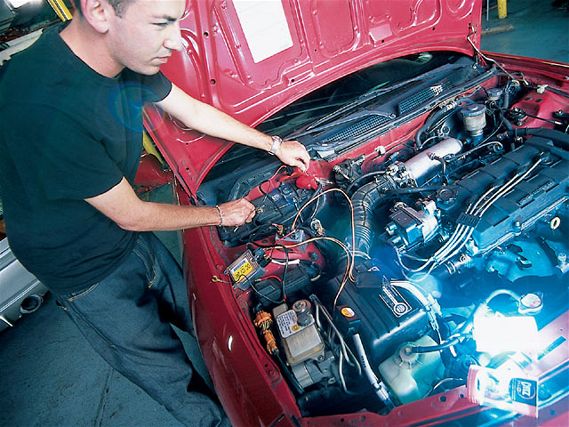 | HID Headlight - Bolt-On Sunshine
| HID Headlight - Bolt-On Sunshine
Chances are you know what an HID headlight is. Utilizing an arc tube that controls ultraviolet emissions, an HID "bulb" is actually a casing holding two separate electrodes and xenon gas. When an electrical charge is supplied, the resulting electric discharge emits light which is controlled by any direct-light diffusers, the shape of the entire headlight housing, and the internal reflective design of the housing itself. The result is a light output that uses 30- to 50% less current, shines three to four times brighter than the most powerful halogen-based bulb, and offers excellent reflective patterns (taking full advantage of the special phosphorous-based reflectors found on federal and state Department of Transportation signage). Also, HID just plain looks cool.
Federal regulations are currently in the air about the "legality" of HID headlights. In true American democratic fashion, HID headlights are both legal and illegal, in a sense. Legal, because most "general language" rules (including the ever-popular FMVSS 108 standard that controls lighting on automotive vehicles) don't specifically prohibit them. Illegal, because most "general language" rules (that FMVSS 108 standard again) prohibit altering your headlights in such a way as to change the basic manner in which light is produced and controlled. Since the industry- standard halogen bulb has a filament, and HIDs do not, swapping out a factory halogen system with an HID system doesn't necessarily violate any laws, but at the same time it does. Confused? Good-that's the gist of what I've learned after weeks of research. It's all about semantics and cunning linguists-or is it cunning word play? Well, this is Import Tuner, home of the "Barely Street Legal," so I decided to forge ahead anyway, regardless of the "fine print" legal matters.
FET Inc., makers of CATZ lighting products, has recently introduced HID conversion kits that fit most popular bulb sizes at a fraction of the cost of any custom or OEM direct conversions. While we're talking about OEM and JDM and all that jazz, FET/CATZ also produces many of the O.E. lighting systems outside of the United States, so you can rest assured that when it claims a failure rate of less than 1 part per million, it isn't feeding you a bunch of cat's turds. To confuse the issue even more, CATZ has already received both DOT and SAE approval for the igniter and ballast sections of the kits and are currently waiting for approval on the actual bulb housing. However, since we're on the strictest of budgets (we don't spend more money than we can borrow) we quickly jumped at the chance to test a set of CATZ 9006 conversions bulbs for our Acura Integra, which has been lovingly dubbed "The Rolling Testbench."
Ideally, we were supposed to do a full-featured how-to-install article, thinking the ballast, igniter and bulb combination would take some time to do. However, by following the directions given by CATZ, we netted a total installation time of 20 minutes. We thought of parlaying the step-by-step installation altogether, saving us from the inevitable "How many 2NR editors does it take to change a lightbulb?" routine you all have waiting for us, but the thought of 20,000 volts running through anybody's unseasoned hands is enough to make us bite the bullet and present to you the following brief, informative, and altogether humiliating tech how-to. Follow along and try not to let the red and black wires touch each other.
ResourceAre my neon plaid windshield wipers and LED muffler spotlights legal?
www.nhtsa.dot.gov/cars/rules/import/FMVSS/
